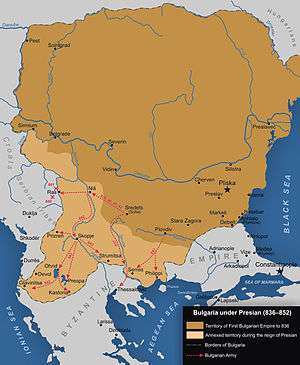Bulgar–Serb War (853)
The Bulgarian-Serbian War of 853 was fought between the Bulgarian Khanate and the Serbian Principality. It was the second conflict of the medieval Bulgarian–Serbian Wars.[1][2][3]
| Bulgar-Serb War (853) | |||||||
|---|---|---|---|---|---|---|---|
| Part of the Bulgarian–Serbian Wars (medieval) | |||||||
.png) Serb lands in the 9th century | |||||||
| |||||||
| Belligerents | |||||||
| Bulgarian Khanate | Serbian Principality | ||||||
| Commanders and leaders | |||||||
| Vladimir-Rasate |
Mutimir Strojimir Gojnik | ||||||
| Casualties and losses | |||||||
| Vladimir and 12 boyars captured | |||||||

Prelude and the War
After the death of Prince Vlastimir of Serbia in c. 850, his state was divided between his sons. Vlastimir and Presian, Boris' father, had fought each other in the Bulgar-Serb War (839–42), which resulted in a Serbian victory. Boris sought to avenge that defeat, an in 853 or 854, the Bulgar army led by Vladimir-Rasate, the son of Boris I, invaded Serbia, with the aim to replace the Byzantine overlordship on the Serbs. The Serbian army was led by Mutimir and his two brothers, who defeated the Bulgars, capturing Vladimir and 12 boyars.[4] Boris I and Mutimir agreed on peace (and perhaps an alliance),[1] and Mutimir sent his sons Pribislav and Stefan to the border to escort the prisoners, where they exchanged items as a sign of peace. Boris himself gave them "rich gifts", while he was given "two slaves, two falcons, two dogs, and 80 furs".[5][6][7]
Aftermath
An internal conflict among the Serbian brothers resulted in Mutimir banishing the two younger brothers to the Bulgarian court.[1] Mutimir, however, kept a nephew, Petar, in his court for political reasons.[8] The reason of the feud is not known, though it is postulated that it was a result of treachery.[8] Petar would later defeat Pribislav, Mutimir's son, and take the Serbian throne.
See also
- Bulgarian–Serbian medieval wars
- Bulgar-Serb War (839–42)
- Medieval Bulgarian Army
- Medieval Serbian Army
References
- Fine 1991, pp. 141.
- Ćirković 2004, pp. 15.
- Curta 2006, pp. 145, 167.
- Bury 2008, pp. 373-374.
- F. Raçki, Documenta historiae Chroatie etc., Zagreb, 1877, p. 359.
- П. Шафарик, Славян. древн., II, 1, стр. 289.
- Const. Porphyr., ibid., cap. 32, pp. 154–155
- Đekić, Đ. 2009, "Why did prince Mutimir keep Petar Gojnikovic?", Teme, vol. 33, no. 2, pp. 683–688. PDF
Sources
- Primary sources
- Moravcsik, Gyula, ed. (1967) [1949]. Constantine Porphyrogenitus: De Administrando Imperio (2nd revised ed.). Washington D.C.: Dumbarton Oaks Center for Byzantine Studies.CS1 maint: ref=harv (link)
- Secondary sources
- Bury, John B. (2008) [1912]. History of the Eastern Empire from the Fall of Irene to the Accession of Basil: A.D. 802-867. New York: Cosimo. ISBN 1-60520-421-8.CS1 maint: ref=harv (link)
- Ćirković, Sima (2004). The Serbs. Malden: Blackwell Publishing.CS1 maint: ref=harv (link)
- Curta, Florin (2006). Southeastern Europe in the Middle Ages, 500–1250. Cambridge: Cambridge University Press.CS1 maint: ref=harv (link)
- Fine, John Van Antwerp Jr. (1991) [1983]. The Early Medieval Balkans: A Critical Survey from the Sixth to the Late Twelfth Century. Ann Arbor, Michigan: University of Michigan Press.CS1 maint: ref=harv (link)